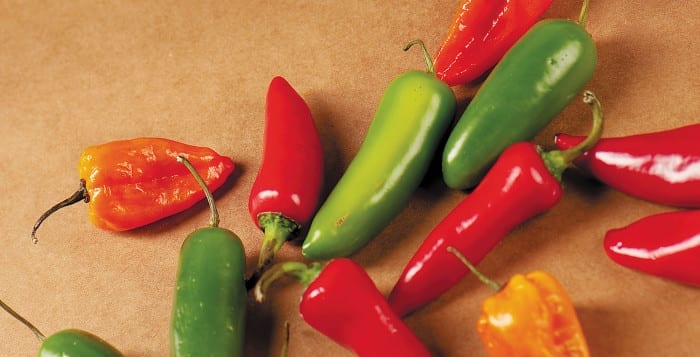Fire up summer with chow-worthy chili tips
By Bob Lipinski
Your mouth is on fire, your heart is pounding, your forehead is perspiring, your eyes are watering, your nose is running, your throat is dry, and still — you want more fire in your mouth. Why do some people enjoy this “fire” while others keep a safe distance from these incendiary little green or red peppers?
Capsaicin, the chemical responsible for the chili’s heat, causes the body to release endorphins (neurochemicals), the body’s natural painkillers that are akin to morphine. These chemicals give the body a sense of well-being and contentment, sparking desire for another round of eating fire. In addition, capsaicin also stimulates pain receptors in the mouth and on the tongue. The brain then orders the mouth to salivate, the nose to run and the gastrointestinal tract to step up its work. The body sweats to cool itself.
Contrary to popular belief, the heat in a chili pepper is not in the seeds. You will find most of the capsaicin in the placenta — the white membrane or veins in the pepper’s middle. However, because the seeds can pick up capsaicin on contact, it’s wise to remove both membrane and seeds if you’re heat shy.
Green chili peppers are high in vitamin C — in fact, one pepper has more vitamin C than an orange; when the red chili deepens in color, the hotter it is and the more vitamins A and C it contains. Chilis are high in fiber and low in calories and they contain no cholesterol or fat.Water does not put out the fire in your mouth because the oily resins in capsaicin are not water soluble.
With chili peppers, the shape generally indicates flavor and heat level. The smaller and narrower the chili, the hotter it is; however, there are exceptions, e.g., the habanero pepper. Hot chili peppers originated in South America, and the precise birthplace is believed to be in the Andean foothills of central Bolivia.
Handling hot chili peppers
When handling chilies, wear rubber gloves, which protect not only the hands but also the face, eyes and other sensitive areas with which the hands come in contact. After working with chilies, wash your hands, the cutting board, the knife and the rubber gloves thoroughly with hot, soapy water.
Putting out “The Fire”
Water does not put out the fire in your mouth because the oily resins in capsaicin are not water soluble. It’s the protein casein in milk that acts like a detergent, stripping the capsaicin from the receptors. Milk products such as yogurt, ice cream, sour cream, cheese or even milk puts out the fire. Starchy foods such as bread, pasta, potatoes or rice tend to absorb or dilute capsaicin. Sweet desserts or even honey also helps modify the intense burning.
Pairing chili peppers with beverages
Most people prefer a cold beer to “put out the fire.” Beer and sparkling wines help cleanse the palate with their carbonation while at the same time they slightly anesthetize the inside of mouth. Fruity wines, such as riesling, chenin blanc, Gewürztraminer and white zinfandel afford a good contrast to heat and the fruitiness offsets some of the pepper’s heat. A glass of cold saké, dry white vermouth or even a dry sherry also pairs well. Avoid oaky wines and those full-bodied, red wines that are loaded with tannins. However, smoked chili peppers, such as chipotle, pair well with a red zinfandel or syrah.
Bob Lipinski, a local author, has written nine books, including “Italian Wine Notes” and “Italian Wine & Cheese Made Simple” (available on Amazon.com). He conducts training seminars on wine, spirits and food, in addition to sales, time management and leadership. He can be reached at www.boblipinski.com OR [email protected].







